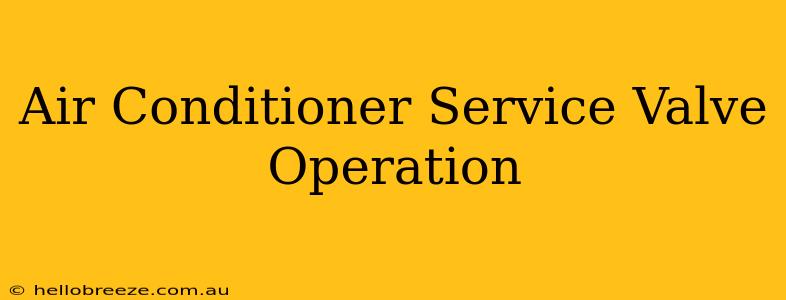Maintaining your air conditioning system is crucial for optimal performance, energy efficiency, and longevity. Understanding how to operate the service valves on your AC unit is a key part of this maintenance. This guide will walk you through the process, explaining the different types of valves and their functions.
Understanding Air Conditioner Service Valves
Service valves, also known as access valves or Schrader valves, are essential components of any air conditioning system. They are typically located on the refrigerant lines connecting the indoor and outdoor units. These valves allow technicians to access the refrigerant lines for charging, evacuating, or recovering refrigerant during servicing and repairs. Improper handling of these valves can lead to leaks and damage to your system, so understanding their operation is vital, even if you're not performing the service yourself.
Types of Service Valves
There are two main types of service valves commonly found on air conditioners:
-
Schrader Valves: These are the most common type and resemble the valves found on car tires. They have a core that is pushed in to open the valve and allow refrigerant flow. They are typically capped to prevent leaks when not in use.
-
Ball Valves: These valves offer a more robust and leak-resistant solution. They use a rotating ball to control refrigerant flow. A quarter turn opens or closes the valve.
How to Operate Air Conditioner Service Valves (For Technicians Only!)
Disclaimer: Working with refrigerant requires specialized knowledge, training, and safety equipment. Do not attempt to service your AC unit yourself unless you are a qualified HVAC technician. Incorrect handling of refrigerant can lead to serious injury or damage to your system. This section is intended for informational purposes for qualified professionals only.
Accessing the Valves
Locate the service valves on the refrigerant lines connecting your indoor and outdoor AC units. These are usually near the connections, clearly marked with labels or color-coding.
Opening and Closing Schrader Valves
To open a Schrader valve, use a service valve tool (not a tire gauge) to firmly depress the core. You should hear a slight hiss of refrigerant as the valve opens. To close it, simply release the tool. Ensure the valve cap is securely replaced afterward to prevent leaks.
Opening and Closing Ball Valves
To open a ball valve, rotate the handle a quarter turn. A clear indication of open or closed position is usually visible on the valve itself. To close, rotate the handle another quarter turn.
Important Considerations for Technicians
- Refrigerant Safety: Always handle refrigerant with care. Use appropriate safety equipment, including gloves and eye protection. Work in a well-ventilated area.
- Leak Detection: Before and after servicing, inspect the valves and lines for leaks using a leak detector.
- Proper Tools: Use the correct tools for servicing the valves to prevent damage.
When to Call a Professional
If you suspect a problem with your air conditioning system, it is crucial to contact a qualified HVAC technician. Don't attempt to diagnose or repair the system yourself. They have the expertise and equipment to safely identify and resolve any issues, including those related to service valves.
Maintaining Your AC System
Regular maintenance is essential for preventing problems and ensuring the longevity of your air conditioning system. This includes annual inspections and servicing by a qualified HVAC technician. Proper maintenance will help to detect any potential issues early on, preventing costly repairs and ensuring your system operates efficiently. Regular maintenance is cheaper than repairs!
By understanding the basic operation of your air conditioner's service valves and when to call a professional, you can ensure the efficient and safe operation of your cooling system for years to come.

